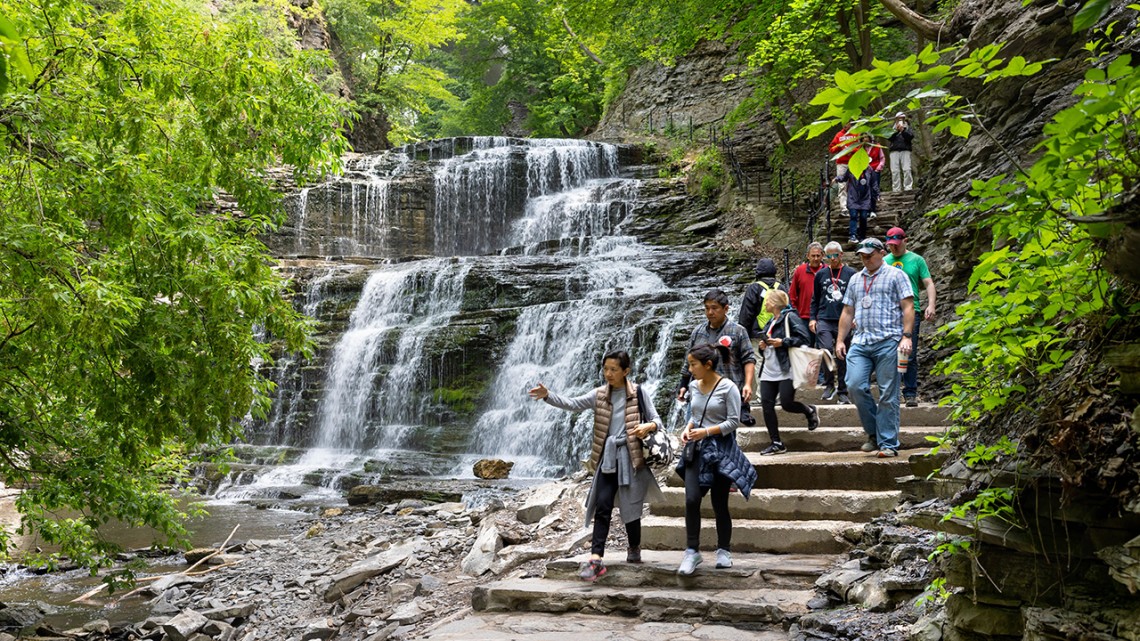
Cornell’s two on-campus gorges inspire and connect the community, but visitors should exercise caution – strong currents and underwater rock ledges make swimming especially dangerous.
Stay safe in Cornell’s gorgeous gorges
By Caitlin Hayes, Cornell Chronicle
Ithaca resident Abigail Williamson grew up with the gorges. And whenever she returns from traveling, or more recently, from college, she is reminded of how striking the gorges are and how special it is to have access to them.
Working for Cornell as a gorge steward this summer, she’ll protect that access by encouraging safe use of Cornell’s two on-campus gorges, educating people about the strong currents and underwater rock ledges that make swimming there so dangerous.
“A lot of people, no matter where they’re from, really have no idea how dangerous the gorges can be,” said Williamson, who graduated from Roberts Wesleyan University in May and is one of 10 gorge stewards, including Cornell students and community members, who are patrolling Cascadilla and Fall Creek gorges on campus. “It’s really important to me that the public has access to these spaces, and the way we can do that is by having people stay safe.”
The Gorge Stewards Program, managed by Cornell Outdoor Education, is one prong of the Nathaniel Rand ’12 Memorial Gorge Safety Education Program, the university’s comprehensive approach to educating the Cornell and Ithaca community about safe use of its iconic gorges and their dangers. Each gorge has areas where unpredictable undertows can lead to fatalities, and steep gorge walls and loose stone pose falling risks. The program was established in 2012 – in honor of a student who accidentally drowned in 2011 – to prevent future tragedies.
The overall program includes the stewards, a Gorge Safety website and signage in and around the gorges, as well as required programming for all new Cornell students; students watch a gorge safety video, receive a brochure and take guided hikes during Orientation. A Gorge Safety Committee, comprising Cornell staff, meets throughout the year to assess the program.
“The committee is really intended to ensure that we’re sharing this information in a proactive way,” said Kevin Perry, director of the Tatkon Center for New Students and co-chair of the Gorge Safety Committee. “We want folks to engage safely and knowledgeably.”
The main rules for gorge safety are: Stay on trails or within designated areas; no bicycles on the trails; and no swimming. Hikers in distress can find red emergency locator signs along the gorge trails to provide their locations to first responders.
Since the gorge safety education program was implemented, the number of violations of gorge regulations has dropped, from more than 8% of all documented users in 2013 to less than 0.5% in 2019. Violations ticked up to 7.4% in 2020, during the pandemic, likely due to limited access to public swimming, but in 2023, violations were down to 2.5%.
“I think one of the biggest pieces of success is introducing the gorges before students even arrive,” Perry said. “Then having that peer-to-peer accountability in those spaces, through the stewards – I think that really helps.”
In addition to encouraging safe use, gorge stewards provide directions and information, survey trails for damage and track traffic and usage, providing data the Gorge Safety Committee can use to assess the program. For swimming, stewards redirect visitors to Ithaca’s many safe outdoor swimming options.
This season, Williamson has already addressed and educated visitors looking to swim in the gorges – but she said the interactions have been warm and friendly, even meaningful.
“People are really open and willing to learn and understand,” she said. “I can relate to why they want to be there, and I can stop and listen, too. Everyone you’re walking past has stories to share.”
She’s spoken with an aspiring environmental engineer who wanted to learn more about how she could protect the gorges, and met a couple moments after they got engaged on Sackett Bridge, overlooking Beebe Lake.
Williamson said the gorges are a common ground.
“When you’re interacting with people in the gorge, we’re all there for the same reason: to get out and enjoy nature,” she said. “Sometimes it’s Cornell students, sometimes it’s locals or tourists from close or far away, and we all get to be in the same place, doing the same thing – which is really cool, how nature can connect us.”
The Cornell Botanic Gardens manages 30 miles of hiking trails on and off-campus, and Tompkins County has more than 240 miles of trails to explore.
Media Contact
Get Cornell news delivered right to your inbox.
Subscribe
